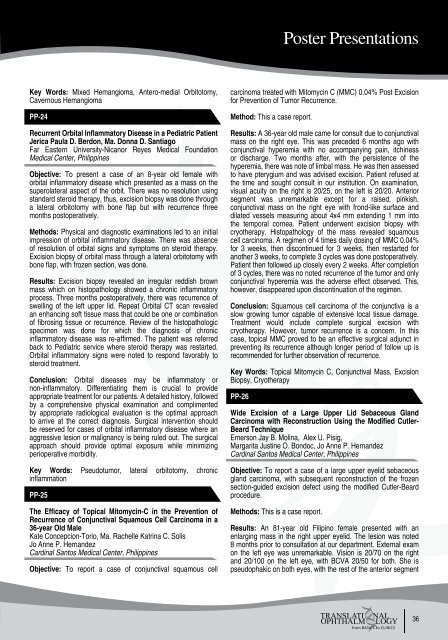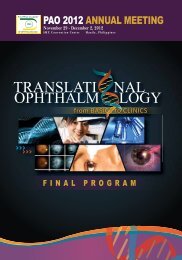Table of Contents - PAO Annual Meeting 2012
Table of Contents - PAO Annual Meeting 2012
Table of Contents - PAO Annual Meeting 2012
You also want an ePaper? Increase the reach of your titles
YUMPU automatically turns print PDFs into web optimized ePapers that Google loves.
Key Words: Mixed Hemangioma, Antero-medial Orbitotomy,<br />
Cavernous Hemangioma<br />
PP-24<br />
Recurrent Orbital Inflammatory Disease in a Pediatric Patient<br />
Jerica Paula D. Berdon, Ma. Donna D. Santiago<br />
Far Eastern University-Nicanor Reyes Medical Foundation<br />
Medical Center, Philippines<br />
Objective: To present a case <strong>of</strong> an 8-year old female with<br />
orbital inflammatory disease which presented as a mass on the<br />
superolateral aspect <strong>of</strong> the orbit. There was no resolution using<br />
standard steroid therapy, thus, excision biopsy was done through<br />
a lateral orbitotomy with bone flap but with recurrence three<br />
months postoperatively.<br />
Methods: Physical and diagnostic examinations led to an initial<br />
impression <strong>of</strong> orbital inflammatory disease. There was absence<br />
<strong>of</strong> resolution <strong>of</strong> orbital signs and symptoms on steroid therapy.<br />
Excision biopsy <strong>of</strong> orbital mass through a lateral orbitotomy with<br />
bone flap, with frozen section, was done.<br />
Results: Excision biopsy revealed an irregular reddish brown<br />
mass which on histopathology showed a chronic inflammatory<br />
process. Three months postoperatively, there was recurrence <strong>of</strong><br />
swelling <strong>of</strong> the left upper lid. Repeat Orbital CT scan revealed<br />
an enhancing s<strong>of</strong>t tissue mass that could be one or combination<br />
<strong>of</strong> fibrosing tissue or recurrence. Review <strong>of</strong> the histopathologic<br />
specimen was done for which the diagnosis <strong>of</strong> chronic<br />
inflammatory disease was re-affirmed. The patient was referred<br />
back to Pediatric service where steroid therapy was restarted.<br />
Orbital inflammatory signs were noted to respond favorably to<br />
steroid treatment.<br />
Conclusion: Orbital diseases may be inflammatory or<br />
non-inflammatory. Differentiating them is crucial to provide<br />
appropriate treatment for our patients. A detailed history, followed<br />
by a comprehensive physical examination and complimented<br />
by appropriate radiological evaluation is the optimal approach<br />
to arrive at the correct diagnosis. Surgical intervention should<br />
be reserved for cases <strong>of</strong> orbital inflammatory disease where an<br />
aggressive lesion or malignancy is being ruled out. The surgical<br />
approach should provide optimal exposure while minimizing<br />
perioperative morbidity.<br />
Key Words: Pseudotumor, lateral orbitotomy, chronic<br />
inflammation<br />
PP-25<br />
The Efficacy <strong>of</strong> Topical Mitomycin-C in the Prevention <strong>of</strong><br />
Recurrence <strong>of</strong> Conjunctival Squamous Cell Carcinoma in a<br />
36-year Old Male<br />
Kate Concepcion-Torio, Ma. Rachelle Katrina C. Solis<br />
Jo Anne P. Hernandez<br />
Cardinal Santos Medical Center, Philippines<br />
Objective: To report a case <strong>of</strong> conjunctival squamous cell<br />
carcinoma treated with Mitomycin C (MMC) 0.04% Post Excision<br />
for Prevention <strong>of</strong> Tumor Recurrence.<br />
Method: This a case report.<br />
Results: A 36-year old male came for consult due to conjunctival<br />
mass on the right eye. This was preceded 6 months ago with<br />
conjunctival hyperemia with no accompanying pain, itchiness<br />
or discharge. Two months after, with the persistence <strong>of</strong> the<br />
hyperemia, there was note <strong>of</strong> limbal mass. He was then assessed<br />
to have pterygium and was advised excision. Patient refused at<br />
the time and sought consult in our institution. On examination,<br />
visual acuity on the right is 20/25, on the left is 20/20. Anterior<br />
segment was unremarkable except for a raised, pinkish,<br />
conjunctival mass on the right eye with frond-like surface and<br />
dilated vessels measuring about 4x4 mm extending 1 mm into<br />
the temporal cornea. Patient underwent excision biopsy with<br />
cryotherapy. Histopathology <strong>of</strong> the mass revealed squamous<br />
cell carcinoma. A regimen <strong>of</strong> 4 times daily dosing <strong>of</strong> MMC 0.04%<br />
for 3 weeks, then discontinued for 3 weeks, then restarted for<br />
another 3 weeks, to complete 3 cycles was done postoperatively.<br />
Patient then followed up closely every 2 weeks. After completion<br />
<strong>of</strong> 3 cycles, there was no noted recurrence <strong>of</strong> the tumor and only<br />
conjunctival hyperemia was the adverse effect observed. This,<br />
however, disappeared upon discontinuation <strong>of</strong> the regimen.<br />
Conclusion: Squamous cell carcinoma <strong>of</strong> the conjunctiva is a<br />
slow growing tumor capable <strong>of</strong> extensive local tissue damage.<br />
Treatment would include complete surgical excision with<br />
cryotherapy. However, tumor recurrence is a concern. In this<br />
case, topical MMC proved to be an effective surgical adjunct in<br />
preventing its recurrence although longer period <strong>of</strong> follow up is<br />
recommended for further observation <strong>of</strong> recurrence.<br />
Key Words: Topical Mitomycin C, Conjunctival Mass, Excision<br />
Biopsy, Cryotherapy<br />
PP-26<br />
Wide Excision <strong>of</strong> a Large Upper Lid Sebaceous Gland<br />
Carcinoma with Reconstruction Using the Modified Cutler-<br />
Beard Technique<br />
Emerson Jay B. Molina, Alex U. Pisig,<br />
Margarita Justine O. Bondoc, Jo Anne P. Hernandez<br />
Cardinal Santos Medical Center, Philippines<br />
Objective: To report a case <strong>of</strong> a large upper eyelid sebaceous<br />
gland carcinoma, with subsequent reconstruction <strong>of</strong> the frozen<br />
section-guided excision defect using the modified Cutler-Beard<br />
procedure.<br />
Methods: This is a case report.<br />
Poster Presentations<br />
Results: An 81-year old Filipino female presented with an<br />
enlarging mass in the right upper eyelid. The lesion was noted<br />
8 months prior to consultation at our department. External exam<br />
on the left eye was unremarkable. Vision is 20/70 on the right<br />
and 20/100 on the left eye, with BCVA 20/50 for both. She is<br />
pseudophakic on both eyes, with the rest <strong>of</strong> the anterior segment<br />
36



